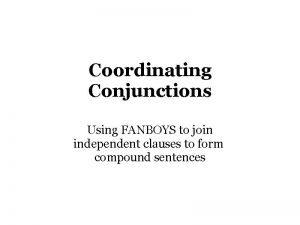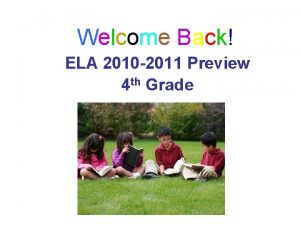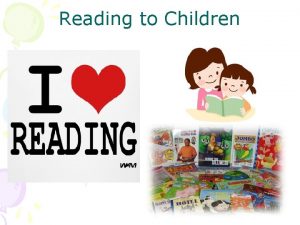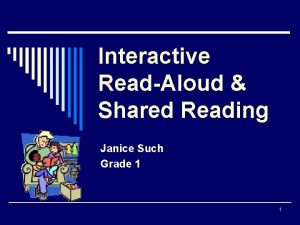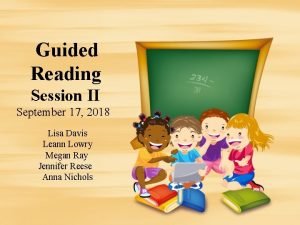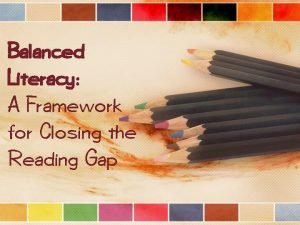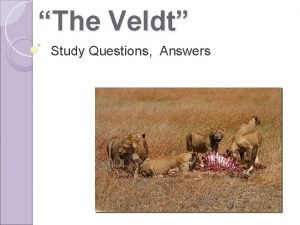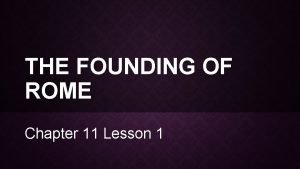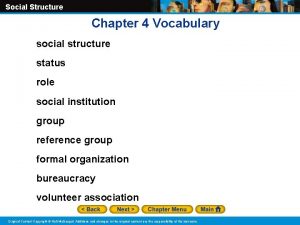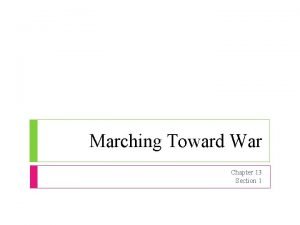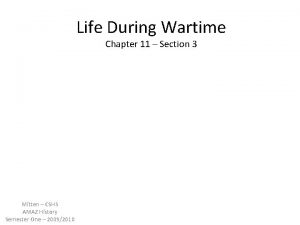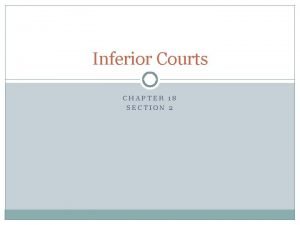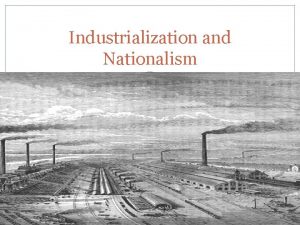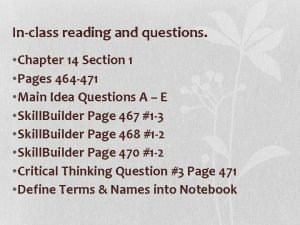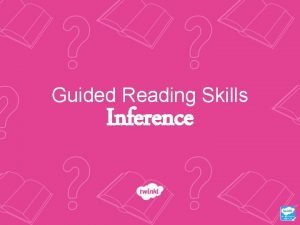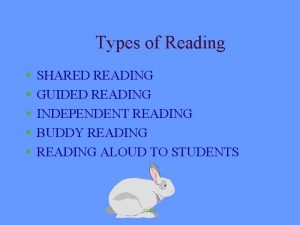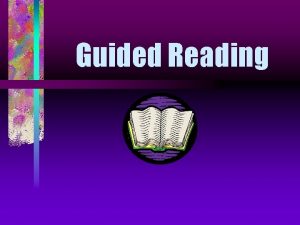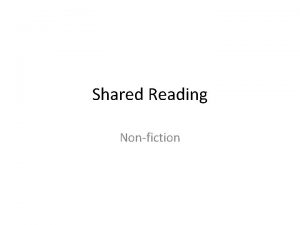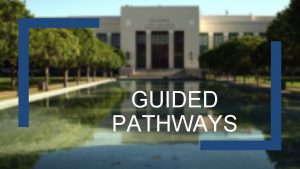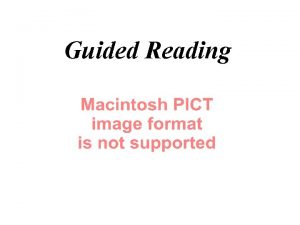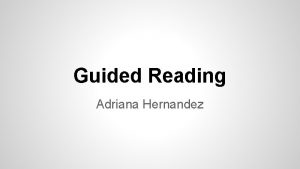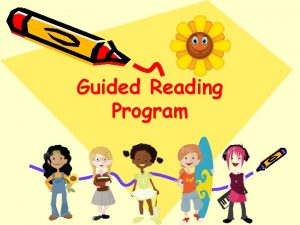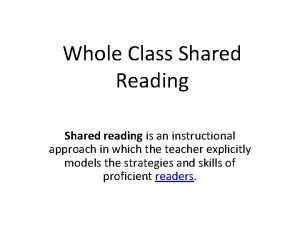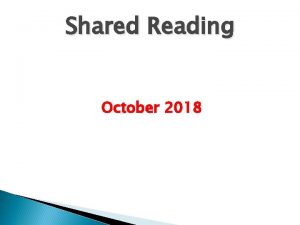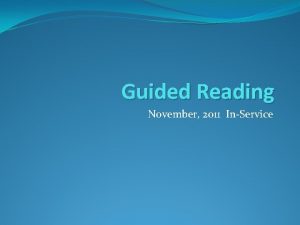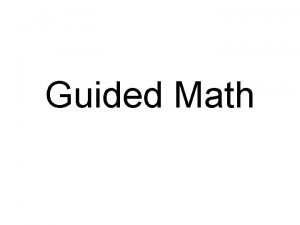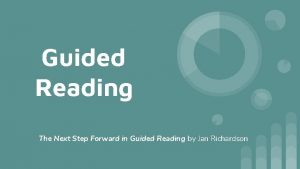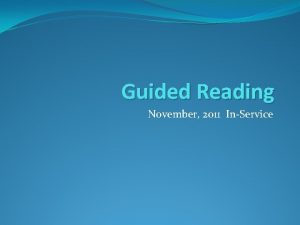Types of Reading SHARED READING GUIDED READING INDEPENDENT


















- Slides: 18

Types of Reading § § § SHARED READING GUIDED READING INDEPENDENT READING BUDDY READING ALOUD TO STUDENTS slide 1

Shared Reading § Teacher reads aloud while students follow along using individual copies of book, a class chart, or a big book.

Types of Shared Reading: § ONE STUDENT READING TO ANOTHER STUDENT § TEACHER TO A CLASS (BIG BOOKS) § THE CLASS READS TOGETHER

GUIDED READING § TEACHERS USE THE PREDICITION CYCLE TO GUIDE AS THEY READ A TEXT

Ways to use Guided Reading § TEACHER DIRECTED READING IN (SMALL GROUPS) § TEACHER AND STUDENTS TALK ABOUT THE READING § WORKS WELL IN CLASS DISCUSSION

Independent Reading § Students read a text independently and often choose the text themselves § Most Authentic Type of Reading

How To Use This In A Classroom: § SILENT READING § STUDENTS GET TO CHOOSE THE BOOK OR TOPIC IN WHICH THEY WANT TO READ § READING NEEDS TO BE AGE APPORPRITE

Buddy Reading § Two Students read or reread a text together

Why Buddy Up? Up § GOOD ALTERNATIVE TO INDEPENDENT READING § STUDENTS GET SUPPORT FROM EACH OTHER

Reading Aloud To Students § Teacher or other fluent reader reads aloud to students

How it is used: § Done in all grade levels § Done to model what strategies good readers use

Connecting Reading and Writing

Reading contributes to students writing development, and writing contributes to students reading development

Using Reading and Writing in the Classroom § Involve students in reading and writing experiences every day § Introduce reading and writing processes in Kindergarten § Expect students reading and writing to reflect their stage of literacy development § Make the reading-writing connection explicit to students

Using Reading and Writing in the Classroom Continued § Emphasize both the processes and the products of reading and writing § Emphasize the functions for which students use reading and writing § Teach reading and writing through authentic literacy experiences

THE END THANK YOU!!!

Reference Page § Micro. Soft Power Point (Slide Show) § Tompkins, Gail (1997) Literacy For The 21 st Century. Prentice Hall, Chapter 7. § Types Of Reading Pages 257 -258 § Connecting Reading And Writing Pages 275 -277. § Using Reading And Writing In The Classroom Page 278.

Reference Page Continued § EDUC 231: Reading Practice In the Classroom (Chapter Presentation) § Sheila Macallair Chapter 7 • The Reading and Writing Process
 Definition of guided reading
Definition of guided reading Fanboys connectors
Fanboys connectors Shared reading vs read aloud
Shared reading vs read aloud Shared reading vs read aloud
Shared reading vs read aloud Shared reading vs read aloud
Shared reading vs read aloud Difference between shared reading and read aloud
Difference between shared reading and read aloud Balanced literacy definition
Balanced literacy definition The veldt discussion questions answers
The veldt discussion questions answers Guided reading lesson 1 the founding of rome answer key
Guided reading lesson 1 the founding of rome answer key Difference between courting and dating
Difference between courting and dating Trc grade level chart
Trc grade level chart Social structure guided reading section 4
Social structure guided reading section 4 Chapter 13 section 1 guided reading marching toward war
Chapter 13 section 1 guided reading marching toward war Life during wartime chapter 11 section 3
Life during wartime chapter 11 section 3 Chapter 9, section 1: labor and wages worksheet answers
Chapter 9, section 1: labor and wages worksheet answers Section 2 guided reading and review the inferior courts
Section 2 guided reading and review the inferior courts Lesson quiz 10-1 industrialization and nationalism
Lesson quiz 10-1 industrialization and nationalism Guided reading chapter 14 section 1
Guided reading chapter 14 section 1 Guided reading inference
Guided reading inference

